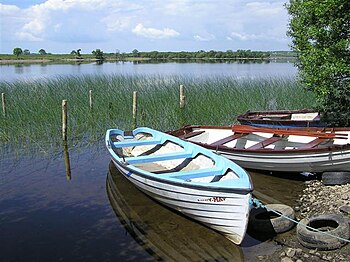Lough Melvin
Lough Melvin is a large lake on the border between Fermanagh in the United Kingdom and County Leitrim in the Republic of Ireland. It is internationally renowned for its unique range of plants and animals.
The lake covers an area of 5,000 acres and is famous for its early run of Atlantic salmon. In relatively pristine condition, the lake and surrounding catchment area of a hundred square miles is valued for its recreational, heritage and environmental values by anglers, tourists, scientists and the local community. Otters, Arctic char, and three species of trout (sonaghan, gillaroo, ferox) are among the many species that live in or around the lake. Within the catchment, the endangered globeflower, Molinia meadows and sessile oak woodlands can be found.[1]
Contents
Conservation and protection
The diversity and rarity of Lough Melvin and its species have led to its being proposed as a 'Special Area of Conservation'. Within the Lough Melvin basin are two other such areas (Arroo Mountain and West-Fermanagh Scarplands).
Lough Melvin is designated a nature reserve and an 'Area of Special Scientific Interest' in the United Kingdom and an Area of Outstanding Beauty and Area of High Visual Amenity in Ireland.[2][3]
Fish and angling
Lough Melvin is one of Ireland's famous angling loughs offering the chance of spring salmon from February to May, grilse from May to July and gillaroo, sonaghan and ferox trout throughout the season. Lough Melvin is also home to an endemic species of char, the Melvin charr or Gray's charr (Salvelinus greyi).[4]
A ghillie or boatman is strongly recommended to anglers unfamiliar with the lake.
Gillaroo trout
Lough Melvin is home to the gillaroo or Salmo stomachius, a species of trout which eats primarily snails. The name "gillaroo" is derived from the Irish language Giolla Rua, which means "Red Fellow": this is due to the fish's distinctive colouring. It has a bright buttery golden colour in its flanks with bright crimson and vermillion spots. The gillaroo feed almost exclusively on bottom living animals (snails, sedge fly larva and freshwater shrimp) with the exception of late summer when they come to the surface to feed and may be caught on the dry fly.[5]
Sonaghan trout
The sonaghan trout (Salmo nigripinnis) is another species of salmonid unique to Lough Melvin. It can have a light brown or silvery hue with large, distinctive black spots. Its fins are dark brown or black with elongated pectorals. Sonaghan are found in areas of open, deep water, where they feed on mid-water planktonic organisms such as water fleas (Cladocera), midge (chironomid) pupae and phantom (Chaoborus) larvae.
Sonaghan will be most readily located close to the surface over deep water. Fly-fishing with a team of wet flies fished in classic lough style (which is to say short, snappy casts from a boat drifting beam-on to the breeze) gives best chance of success. Sonaghan give a powerful and energetic fight out of all proportion to their size.[6]
Ferox trout
The classic work carried out by Andrew Ferguson of Queen's University on the genetics of the trout of Lough Melvin identified the ferox as a separate subspecies. The fish home to a specific spawning area and are reproductively isolated. They are also one of the oldest trout races to colonise Ireland, perhaps as old as 50,000 years.
Ferox cannibalise brown trout (which returned to many of the same lakes when geological processes and climatic conditions allowed) and also prey on other fish species. The best method of capture is trolling, particularly with a Rapala type lure.[7]
Folklore
Local folklore tells of an old monk who was fishing late one night at the boat quay in the Rusheen – this is apparently the origins of the Gillaroo myth. The old monk had fasted for a long period and had nestled on Lough Melvin's rocky shores in spiritual contemplation.
Upon completing his period of abstinence, the monk combed the surrounding landscape to quench his appetite. He acquired a bounty of wild mushrooms from the grassy slopes of the Rusheen then proceeded to seek an adequate complement to his fungal feast. Lough Melvin he knew should provide the perfect source, for having spent many days gazing upon its vast expanse he had watched in awe at the abundance of wild salmon and various trout-like fish that frolicked in pursuit of unsuspecting insect life. After an evening's fishing though his only catch was an eel which was hardly was worth roasting and a duck egg that he had managed to retrieve from a nest in a nearby reed bed. Becoming ever increasingly desperate and starving the monk decided to make a cross in the sand and laid his catch within – this is why they say an eel will not leave a cross of sand if caught in the Lough. It was now that the monk turned to his spiritual adviser asking him to reward him for his faithful fast. On opening his eyes, the monk saw that his eel and egg had turned into two of the most beautiful golden bellied trout; a fish so splendid that he simply could not eat, so he turned them free to multiply in the Lough.
Outside links
| ("Wikimedia Commons" has material about Lough Melvin) |
References
- ↑ Lough Melvin Programme
- ↑ Lough Melvin ASSI
- ↑ Lough Melvin SAC (UK)
- ↑ Fishbase – Salvelinus grayi
- ↑ The Trouts – Gillaroo Irish Char Conservation Group
- ↑ The Trouts – Sonaghen Irish Char Conservation Group
- ↑ The Trouts – Ferox Irish Char Conservation Group
- Clenaghan, Conor; Clinton, Frank; Crowe, Matthew: 'Phosphorus Regulations National Implementation Report': Environmental Protection Agency, Office of Environmental Enforcement, 2005
- Pedreschi, D.; Kelly-Quinn, D.; Caffrey, M.; O'Grady, J.; Mariani, S.; Phillimore, A.: 'Genetic structure of pike (Esox lucius) reveals a complex and previously unrecognized colonization history of Ireland' (Journal of Biogeography, 41(3), 548–560)

